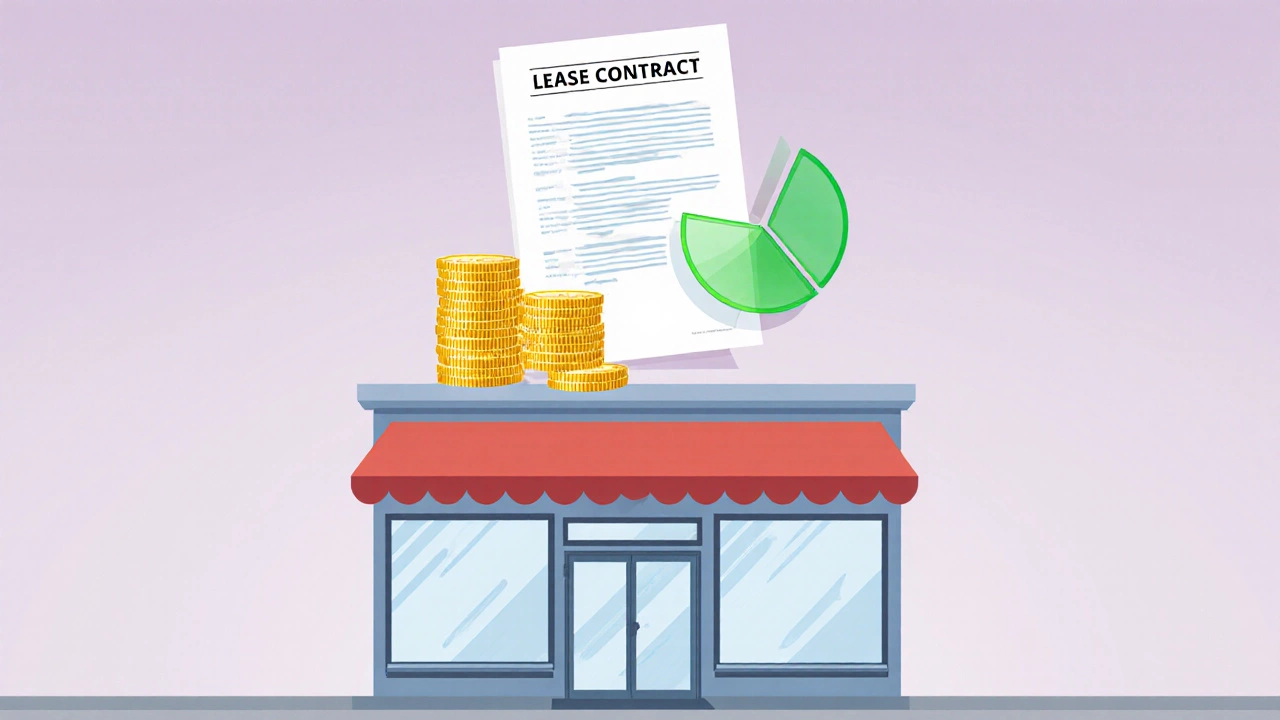Backsplit Lease Calculator
Backsplit Lease Calculator
Quick Takeaways
- A backsplit lease blends a fixed rent with a percentage of the tenant’s turnover.
- It’s popular in retail and hospitality where sales can fluctuate dramatically.
- Both landlord and tenant share risk - the landlord benefits from high sales, the tenant gains lower base costs.
- Key clauses include the turn‑over reporting method, the split ratio, and the trigger date for the percentage component.
- Legal compliance under Australian property law is essential to avoid disputes.
When you see a lease that mentions a backsplit, you’re looking at a hybrid rent structure. It isn’t a brand‑new buzzword - Australian landlords have been using it for years to attract tenants who need cash‑flow flexibility. Below we break down exactly what a backsplit is, how it works, who benefits, and what to watch out for.
What Is a Backsplit?
Backsplit is a rent arrangement that combines a fixed base rent with a percentage of the tenant’s gross turnover after a pre‑agreed start date. It’s a type of percentage lease often seen in retail and hospitality sectors.
The term comes from the idea that the “split” of rent kicks in “back” in the lease term - usually after an initial rent‑free or low‑rent period.
How a Backsplit Lease Works
Think of the lease as two layers:
- Base rent - a set amount payable weekly or monthly from day one.
- Turn‑over rent - a percentage of the tenant’s sales that starts after the trigger date.
For example, a coffee shop might pay $2,000 per month plus 5% of gross sales once monthly turnover exceeds $40,000. If sales are $50,000 in a given month, the extra rent would be 5%×($50,000-$40,000)=$500, making the total rent $2,500 for that month.
Key variables that shape the backsplit:
- Trigger date - the point in the lease when the percentage component starts (e.g., after 12 months, after reaching a sales threshold, or after a rent‑free period).
- Split ratio - the percentage of turnover the landlord receives (commonly 3‑10%).
- Reporting method - how turnover is measured (POS reports, audited statements, etc.).

Typical Scenarios Where Backsplit Leases Shine
Backsplits shine when the tenant’s cash flow is uncertain but the location promises high traffic. Common use cases include:
- Retail shops in shopping centres where foot traffic can vary seasonally.
- Restaurants and cafes that need a low upfront rent while they build a customer base.
- Fitness centres that charge members per visit and want rent to reflect member numbers.
- Pop‑up or temporary stores that expect a short, high‑volume burst (e.g., holiday markets).
In contrast, a pure fixed‑rent lease would lock the tenant into a constant cost regardless of sales, which can be risky for new businesses.
Pros and Cons for Landlords and Tenants
Both sides share the risk and reward, but the balance differs:
| Aspect | Backsplit | Fixed Rent | Pure Percentage Rent |
|---|---|---|---|
| Cash‑flow risk for tenant | Lower early cash‑outlay, risk rises with sales | Predictable, but may be high during slow periods | Very low base cost, but rent can spike |
| Income stability for landlord | Mix of steady base + upside from growth | Steady, but no upside if sales surge | Variable, can be low if tenant underperforms |
| Complexity of administration | Requires regular turnover reporting and audits | Simple - just collect rent | High - continuous monitoring of sales figures |
| Negotiation flexibility | High - can tailor trigger dates, ratios, caps | Low - rent is fixed at outset | Medium - often includes minimum rent floors |
Landlords love the upside potential, while tenants appreciate the safety net of a lower base rent during the early stages.
Step‑by‑Step: Calculating Backsplit Rent
Let’s walk through a realistic example for a boutique clothing store:
- Set the base rent: $3,000 per month.
- Agree on the split ratio: 6% of gross turnover.
- Define the trigger date: After the first 12 months.
- Determine the turnover threshold: No threshold - percentage applies to all sales after month 12.
- Collect monthly turnover data: Month 13 turnover = $80,000.
- Calculate percentage rent: 6%×$80,000 = $4,800.
- Add base rent: $3,000 + $4,800 = $7,800 total rent for month 13.
If sales dip to $50,000 in month 14, the percentage portion drops to $3,000, making total rent $6,000. This fluidity helps the tenant stay viable when business slows.

Legal and Compliance Checklist in Australia
Backsplits are enforceable under the same commercial lease legislation that governs all rental agreements. Here are the must‑do items:
- Clear definition of turnover - specify whether gross sales, net sales, or a particular line item is used.
- Audit rights - landlord should have the right to verify figures, either through an independent auditor or by reviewing POS reports.
- Reporting frequency - monthly or quarterly, with a set deadline (e.g., 10 business days after month‑end).
- Cap or floor - many leases include a maximum percentage rent or a minimum base rent to protect both parties.
- Dispute resolution - include mediation or arbitration clauses to handle turnover disagreements.
- Compliance with GST - ensure turnover figures are reported before GST is added, unless otherwise agreed.
Because the backsplit hinges on financial data, transparency is non‑negotiable. Both landlord and tenant should seek legal advice to draft clauses that prevent future conflict.
When Not to Use a Backsplit
Even though backsplits sound ideal, they’re not a one‑size‑fits‑all solution. Avoid them if:
- The business has highly predictable cash flow (e.g., a bank office) - a fixed rent is simpler.
- The tenant cannot reliably track turnover (no POS system).
- Landlord prefers a steady income stream without the overhead of audits.
- Market data shows that turnover percentages would rarely exceed the base rent, rendering the split pointless.
In such cases, consider a traditional fixed lease or a pure percentage lease with a minimum rent floor.
Next Steps for Landlords and Tenants
If you think a backsplit could fit your situation, follow these practical steps:
- Audit your commercial property and confirm the tenant’s business model aligns with a turnover‑based rent.
- Engage a qualified property solicitor to draft the lease, paying close attention to turnover definitions and audit rights.
- Set up a reliable POS or accounting system that can generate the required sales reports automatically.
- Agree on a split ratio that reflects market norms - typical ranges are 3‑10% for retail.
- Include a review clause that allows renegotiation after a set period (often 3‑5 years) to adjust for inflation or market shifts.
Doing the groundwork up front prevents headaches later and creates a win‑win rent structure.
Frequently Asked Questions
What’s the difference between a backsplit and a pure percentage lease?
A backsplit always includes a base rent component, whereas a pure percentage lease may have little or no fixed rent, relying solely on turnover. The backsplit therefore offers more predictable income for the landlord.
Can the split ratio be changed during the lease?
Only if both parties agree and the change is recorded in a lease variation. Most leases lock the ratio for the initial term and may allow renegotiation at a review point.
How is turnover defined for a restaurant?
Turnover typically means gross sales before any deductions (food cost, GST, staff wages). The lease should spell out the exact definition to avoid disputes.
Do I need an accountant to verify turnover?
Many landlords require an independent audit annually, but monthly figures can be self‑reported if the lease includes audit rights and clear reporting standards.
What happens if the tenant underreports sales?
The lease’s audit clause allows the landlord to demand an independent audit. If underreporting is proven, the tenant may be liable for back‑rent, interest, and possibly penalties.
Backsplits can be a clever tool for aligning landlord and tenant interests, especially in dynamic retail environments. By understanding the mechanics, weighing the pros and cons, and ensuring airtight legal language, both parties can enjoy a fair, adaptable rent structure.

